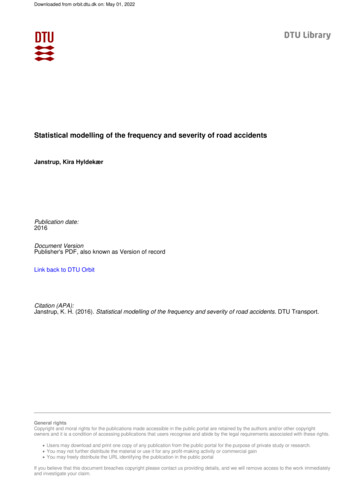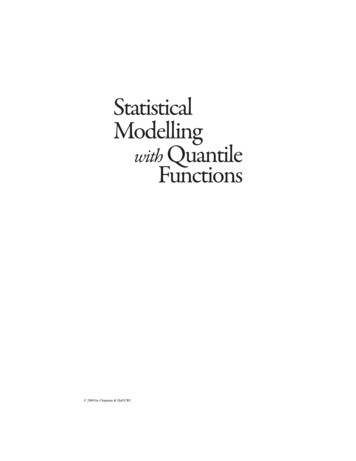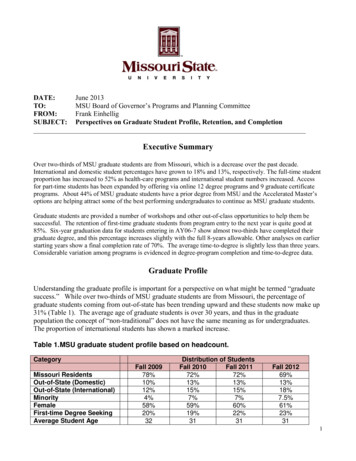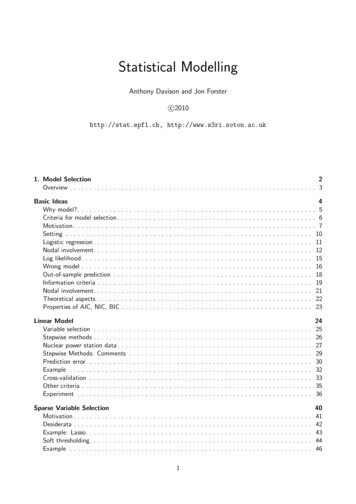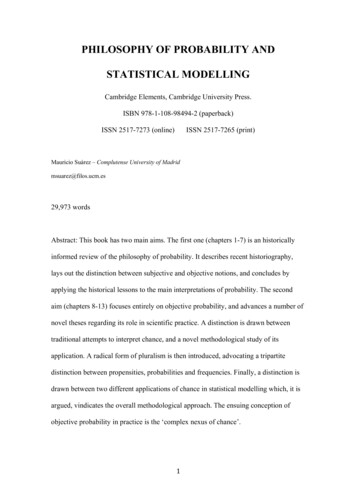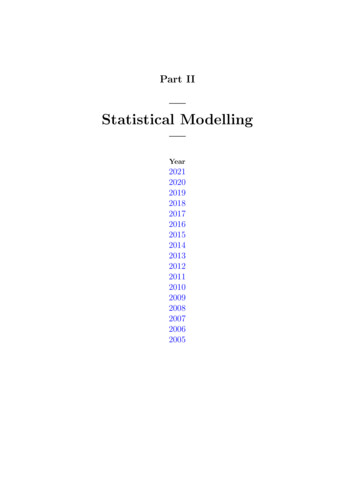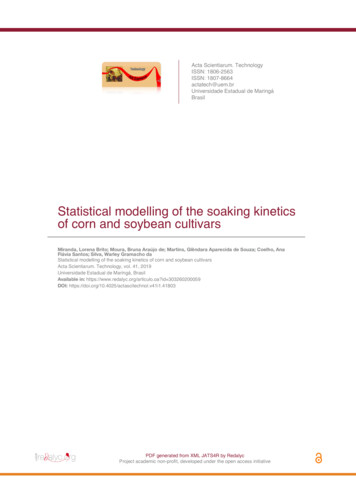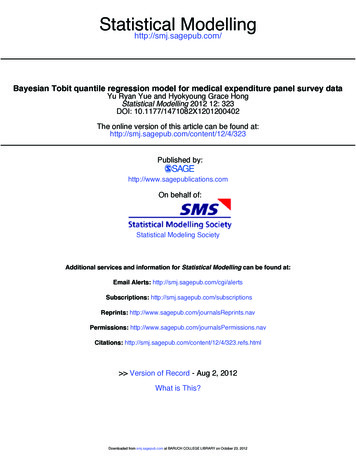
Transcription
n Tobit quantile regression model for medical expenditure panel survey dataYu Ryan Yue and Hyokyoung Grace HongStatistical Modelling 2012 12: 323DOI: 10.1177/1471082X1201200402The online version of this article can be found d by:http://www.sagepublications.comOn behalf of:Statistical Modeling SocietyAdditional services and information for Statistical Modelling can be found at:Email Alerts: http://smj.sagepub.com/cgi/alertsSubscriptions: http://smj.sagepub.com/subscriptionsReprints: ions: tions: http://smj.sagepub.com/content/12/4/323.refs.html Version of Record - Aug 2, 2012What is This?Downloaded from smj.sagepub.com at BARUCH COLLEGE LIBRARY on October 23, 2012
July 12, 201215:5702-SMJ-12-4Statistical Modelling 2012; 12(4): 323–346Bayesian Tobit quantile regression model for medicalexpenditure panel survey dataYu Ryan Yue1 and Hyokyoung Grace Hong11Zicklin School of Business, Baruch College, The City University of New York, New York.Abstract: High expenditure on healthcare is an important segment of the U.S. economy, makinghealthcare cost modelling valuable in decision-making processes over a wide array of domains. In thispaper, we analyze medical expenditure panel survey (MEPS) data. Tobit regression model has beenpopularly used for the medical expenditures. However, it is no longer sufficient for the MEPS databecause: (i) the distribution of the expenditures shows skewness, heavy tails and heterogeneity; (ii)most predictors are categorical, including binary, nominal and ordinal variables; (iii) there are a fewpredictors which may be nonlinearly related to the response. We therefore propose a Bayesian Tobitquantile regression model to describe a complete distributional view on how the medical expendituresdepend on the various predictors. Specifically, we assume an asymmetric Laplace error distributionto adapt the quantile regression to a Bayesian setting. Then, we propose a modified group Lasso forcategorical factor selection, and a smoothing Gaussian prior for modelling the nonlinear effects. Theestimates and their uncertainties are obtained using an efficient Monte Carlo Markov Chain samplingmethod. The effectiveness of our approach is demonstrated by modelling 2007 MEPS data.Key words: asymmetric Laplace distribution; group lasso; MCMC; medical expenditure panel survey;nonlinear effect; Tobit quantile regressionReceived November 2011; revised December 2011; accepted December 20111 Introduction1.1 Medical expenditure panel survey dataThe Medical Expenditure Panel Survey (MEPS), which began in 1996, is a set of largescale surveys of families and individuals, their medical providers (doctors, hospitals,pharmacies, etc.), and employers across the United States. The MEPS collects dataon the specific health services that Americans use, how frequently they use them, thecost of these services and how they are paid for, as well as data on the cost, scope andbreadth of health insurance held by and available to U.S. workers. It intended to provide nationally representative estimates of health expenditure, utilization, paymentAddress for correspondence: Yu Ryan Yue, Zicklin School of Business, Baruch College, The CityUniversity of New York, New York, NY 10010. E-mail: yu.yue@baruch.cuny.educ 2012 SAGE Publications!10.1177/1471082X1201200402Downloaded from smj.sagepub.com at BARUCH COLLEGE LIBRARY on October 23, 2012
July 12, 201232415:5702-SMJ-12-4Yu Ryan Yue and Hyokyoung Grace Hongsources, income, employment, health status and health insurance coverage amongthe non-institutionalized, nonmilitary population of the United States. This seriesof government-produced datasets can be used to examine how individuals interactwith the medical care system in the United States. The current publicly availableMEPS component is the Household Component, consisting of six data files whichdescribe the demographics and characteristics of the survey population and eightevent-level files which capture all interactions with the U.S. medical system. Thefile of our interest is the Full-Year Consolidated Data file, which includes all demographic and medical characteristics, as well as patient-reported responses to the mainsurvey questions. More information about MEPS can be found at its official website:http://www.meps.ahrq.gov/mepsweb/.In this paper, we examine 2007 MEPS data using regression-based approach. Theresponse variable is the total healthcare expenditure (the MEPS variable is totexp07),including insurance spending and annual out-of-pocket spending, measured in dollars. Summary statistics are reported in Table 1. For many econometric explorations,the following prominent features of these expenditure data are typically importantto accommodate. First, the expenditures are, for most practical purposes, nonnegative. Second, a sizable fraction of observations (approximately 17% in the MEPS) aremeasured as zero. As a result, the distribution is a mixture of a point mass in zero anda continuous distribution truncated at zero. Third, the data exhibit a ‘heavy’ uppertail: in the MEPS data, almost 10% of the expenditures exceed 10 000. Fourth, witha small probability, households face extremely large medical expenditure, resulting ina right-skewed distribution; note that skewness per se does not imply a heavy uppertail. These features are clearly shown in Figure 1. As for explanatory variables, thereare socioeconomic factors such as the number of years of education, poverty level,region, etc., and personal characteristics such as self-rated health, general-risk-takingattitude, seat-belt use, etc. Since conventional survey items only allow a limited number of response options, most explanatory variables are categorical, including binary,nominal and ordinal variables.The MEPS data have been extensively used for the econometrical analysis of thehealthcare expenditures (e.g., Cameron and Trivedi, 2010; Clements and Hendry,2011). The high expenditures on healthcare have been an important segment of theU.S. economy, accounting for about 16% of GDP in 2007, highest among all thedeveloped countries. The effective healthcare cost modelling has fundamentally orTable 1 Summary statistics of totalhealthcare expenditure in 2007Observations0.25 Percentile0.50 Percentile0.75 Percentile0.95 PercentileMeanStandard deviation15 8901641152399718 808449812 728Statistical Modelling 2012; 12(4): 323–346Downloaded from smj.sagepub.com at BARUCH COLLEGE LIBRARY on October 23, 2012
July 12, 201215:5702-SMJ-12-4325200 000009001 1000 901801000000 87001000 76001000 65001000 54001000 43001000 30001 22001101 10000010Percentage304050Bayesian Tobit quantile regression model for medical expenditureTotal Healthcare Expenditure ( )Figure 1 Histogram of the medical expenditures in 2007 MEPS dataperipherally informed decision making over a wide array of domains: risk-adjustedprovider payments; provider utilization review/profiling; cost-of-illness assessment;cost aspects of evaluation studies and future projections of disease-specific healthcarecost burdens (Mullahy, 2009).1.2 Statistical modelling of medical expenditure dataThe medical expenditure variable is a so-called limited dependent variable whosedistribution is mostly continuous but has a point mass at one or more specific values,such as zero. There are a multitude of statistical approaches to modelling of a limiteddependent variable, e.g., the two-part model, the Tobit model, the sample selectionmodel (SSM), hurdle models and finite mixture models. For an excellent comprehensive survey of this literature, see Jones (2000). Here, we only briefly review the TobitStatistical Modelling 2012; 12(4): 323–346Downloaded from smj.sagepub.com at BARUCH COLLEGE LIBRARY on October 23, 2012
July 12, 201232615:5702-SMJ-12-4Yu Ryan Yue and Hyokyoung Grace Hongmodel because it is closely related to the method that we are going to propose in thisarticle.The standard ‘Tobit’ (Tobin, 1958) regression model can be easily described usingthe concept of a latent desired level of expenditure, denoted by yi . The classic linearregression model is then used for the latent variable:yi xi" β εi ,iidεi N(0, σ 2 ),where xi contains predictors of interest and error εi follows an identically independentnormal distribution with mean zero and variance σ 2 . The observed expenditure isassumed to be related to the latent value by the following:! yi , if yi 0,yi 0, cally speaking, the Tobit model assumes a so-called single decisionmaking process. The individual chooses the level of medical expenditure that maximizes his or her welfare. Positive expenditures correspond to desired expenditures.Zero expenditure represents a corner solution, in which income and/or preferencesfor health are so low that spending nothing on healthcare is best for the individual (O’Donnell et al., 2008). The regression coefficients β in the Tobit model areususally estimated by maximum likelihood approach and the resulting estimates areconsistent.Unfortunately, the classic Tobit model is not appropriate for the 2007 MEPS data.First, the distribution of the expenditures is highly skewed to the right with a heavyupper tail, making the conditional mean not appropriate to summarize the relationship between the expenditures and the predictors. Using logarithmic transformations20304050Age6070800510Education Years15Figure 2 Violation of homoscedastic assumption: plots of logarithm of healthcare expenditure against Age(left) and Education (right)Statistical Modelling 2012; 12(4): 323–346Downloaded from smj.sagepub.com at BARUCH COLLEGE LIBRARY on October 23, 2012
July 12, 201215:5702-SMJ-12-4Bayesian Tobit quantile regression model for medical expenditure327may relieve the skewness, but this raises the problem of retransforming to the original scale (e.g., dollars rather than log-dollars), in order to make inferences that arerelevant for policy (Duan, 1983). Second, the assumption of homoscedasticity is violated since the variability of errors changes across the subjects (see Figure 2). As aresult, different parts of the distribution may depend on the predictors in differentways. Third, most predictors in the MEPS data are categorical variables, includingboth ordinal and nominal variables. It is well known that the ordinary regressionmodels are not efficient especially when lots of such variables are used as predictors.Fourth, previous empirical research showed that the healthcare costs strongly dependon some predictors, e.g., age, in a nonlinear way (see Alemayehu and Warner, 2004;Jung and Tran, 2010; Bell et al., 2011).1.3 Tobit quantile regressionWe adopt the idea of Tobit quantile regression, which turns out to be an ideal tool toanalyse MEPS data. Again, we describe the model in the latent variable framework,where the observed response variable can then be written as yi max{0, yi }. Givena sample of independent observations y (y1 , . . . , yn ) and associated m covariatesX (x1 , . . . , xm), the latent variable yi is modelled as follows:yi ητ (xi θ) ετ i ,ετ i Fτ i subject to Fτ i (0 xi ) τ,(1.1)where ητ (· θ) is a function with the parameters θ #, and the random error ετ ifollows a cumulative distribution function Fτ i whose τ th quantile conditional on xiequals zero. It is easy to see that model (1.1) defines ητ to be the τ th conditionalquantile function of yi given xi . The error distribution Fτ is often left unspecifiedin the classical literature. Assuming linear model ητ (xi θ) xi" βτ (βτ IR p), anintuitive estimator for the Tobit model under the above quantile restriction solves!n"uτ,u 0,"(1.2)arg minρτ (yi max{0, xi βτ }), where ρτ (u) 1),u 0,u(τβτi 1is the so-called ‘check function’ of Koenker and Bassett (1978).Initiated by Chib’s (1992) work in standard Tobit model, Yu and Stander (2007)pioneered the Bayesian approach of Tobit quantile regression. Their method is basedon assuming an asymmetric Laplace (AL) distribution for the error term ετ i in model(1.1) and using Monte Carlo Markov Chain (MCMC) technique to simulate samples from the model’s posterior distribution. Estimates and their uncertainties canbe easily calculated using the posterior samples. However, Yu and Stander usedMetropolis-Hastings method in their MCMC algorithm rather than took advantageof the mixture representation of AL density to create a more efficient Gibbs sampler.Their approach is thus limited to the simple linear quantile functions only. Taddyand Kottas (2010) proposed a nonparametric method of Tobit quantile regressionStatistical Modelling 2012; 12(4): 323–346Downloaded from smj.sagepub.com at BARUCH COLLEGE LIBRARY on October 23, 2012
July 12, 201232815:5702-SMJ-12-4Yu Ryan Yue and Hyokyoung Grace Hongusing Dirichlet process mixture models for the joint distribution of the response andthe covariates.In this paper, we extend Yu and Stander’s (2007) work by developing a generalBayesian framework for flexible Tobit quantile regression models. The proposedmethod offers following advantages. First, it describes a distributional view of themedical expenditures dependent on the predictors by examining various conditionalquantiles. Second, it takes into account for the point mass at zero of the distribution without lack of convexity problem. Third, appropriate regularization priorsare taken on the categorical predictors, yielding accurate estimation and efficientvariable selection. Fourth, it allows us to consider a possible nonlinear relationshipbetween the medical expenditure and certain predictors. Fifth, it easily provides theBayesian credible intervals for taking into account the uncertainty of estimation.This, however, would be a much harder task for the frequentists who might considerour model setting. Finally, it has an efficient MCMC algorithm to implement theBayesian inference.The remainder of the paper is organized as follows. In Section 2, we present theproposed method, introducing observation model and different kinds of priors. TheMCMC simulation method is shown in Section 3. Results are summarized in Section4, followed by a conclusion in Section 5.2 Bayesian Tobit quantile regression2.1 Observation modelIn order to make Bayesian quantile inference, we need to specify a distribution onlatent variable yi . Following Yu and Stander (2007), we use AL distribution, denotedby AL(η, δ0 , τ ), whose probability density function is given byp(y η, δ0 , τ ) τ (1 τ )δ0 exp { δ0 ρτ (y η)} ,(2.1)where η IR is a location parameter, δ0 0 is a scale parameter and 0 τ 1is a skewness parameter. Since the check function ρτ assigns weight τ or 1 τ tothe observations greater than or less than η, respectively, the τ th quantile of y is ηdespite of the value of δ0 . Another attractive feature about this skewed distributionis that it can be represented as a scale mixture of normals (e.g., Kotz et al., 2001):#Y η ξ W σ Z δ0 1 W, Dwhereξ 1 2τ,τ (1 τ )σ2 2τ (1 τ )(2.2)are two scalars depending on τ . The independent random variables W 0 and Zfollow exponential distribution with mean δ0 1 and standard normal distribution,Statistical Modelling 2012; 12(4): 323–346Downloaded from smj.sagepub.com at BARUCH COLLEGE LIBRARY on October 23, 2012
July 12, 201215:5702-SMJ-12-4Bayesian Tobit quantile regression model for medical expenditure329respectively. This mixture representation makes it easy to sample from AL distribution, leading to its extensive use in Bayesian quantile regression; see, e.g., Yu andMoyeed (2001), Tsionas (2003), Kozumi and Kobayashi (2011) and Yue and Rue(2011).We now define quantile function ητ in model (1.1). For the general representationof categorical predictors x j , we use dummy coding. That means, with K j 1 denotingthe number of factor levels of x j , for each x j we have dummy variables x j0 , . . . , x j K j ,i.e., x jk 1 when x j k and x jk 0 otherwise. We model the continuous variables,which appear to have nonlinear relationships with medical expenditures, as unknownsmooth functions. As a result, a semiparametric additive model is assumed as follows:ητ α p Kj""β jk x jk j 1 k 0q"f* (t* ).(2.3)* 1Note that the α, β jk and f* depend on the τ th quantile. Since the quantiles areestimated separately in our approach, we will not show τ in those notations. Foridentifiability, we specify reference category k 0, so that β j0 0 for all j. We alsoadd sum-to-zero constraint to f* for all * to make them identifiable from α. In matrixnotation, y (y1 , . . . , yn )" denotes the vector of latent response values; X j is thedesign matrix containing observed (non-redundant) dummy variables x j1 , . . . , x j K j ;f* denotes the vector of the function values and P* is the corresponding incidencematrix. Letting β j (β j1 , . . . , β j K j )" , the model has the following matrix form: y α1 p"j 1X jβj q"P* f* ετ ,(2.4)* 1iidwhere 1 (1, . . . , 1)" , ετ (ετ 1 , . . . , ετ n )" and ετ i AL(0, δ0 , τ ). To implementBayesian inference, we need to specify prior distributions on scale parameter δ0 ,coefficients β and unknown functions f* . Following Park and Casella (2008), wetake the non-informative scale-invariant prior p(δ0 ) 1/δ0 on δ0 . Moreover, avague normal prior N(0, δα 1 ) with small precision δα is assigned for α. The priorstaken on β j and f* are described in the following sections.2.2 Group Lasso prior for categorical covariatesIn the MEPS data, most variables are categorical, including ordinal, nominal andbinary factors. For example, the poverty status is given as an ordinal predictor withfive levels, and census region as a nominal with four values. Usually, such data areanalysed via standard linear regression modelling, with dummy coded categorialexplanatory variables. In the present situation, such modelling is possible, since thenumber of observations (n 15 890) is quite high compared to the number of dummyStatistical Modelling 2012; 12(4): 323–346Downloaded from smj.sagepub.com at BARUCH COLLEGE LIBRARY on October 23, 2012
July 12, 201215:5702-SMJ-12-4330Yu Ryan Yue and Hyokyoung Grace Hong pvariables ( j 1 K j 28). Nevertheless, from the viewpoint of interpretation, modelselection is often desired with the focus on reducing model complexity.The group Lasso (Yuan and Lin, 2006) is a modification of the original Lasso(Tibshirani, 1996) which is designed for the selection of grouped variables, as dummycoded factors. It elegantly combines penalization within groups of variables andgroupwise selection by using a Lasso penalty at the factor level, and a ridge-typepenalty within groups of (e.g., dummy) coefficients. For demonstration purposesonly, we here consider the regularized quantile regression model (without nonlinearterms) as in Li et al. (2010):minβn"i 1ρτ (yi xi" β) λJ (β),(2.5)with smoothing parameter λ and penaltyp #"J (β) β "j % j β j ,(2.6)j 1where % j is some positive definite matrix. Via the L1 -norm penalty imposed by thesquare root, the group Lasso encourages sparsity at the factor level. Typically, a(scaled) identity matrix is used for the penalty matrices % j ; see Yuan and Lin (2006)for details.The identity matrix, which has been used for the group Lasso to date, is applicable to categorical predictors in general. Ordinal covariates, however, provide moreinformation than nominal covariates since the labels’ ordering is meaningful. InGertheiss and Tutz (2009) and Gertheiss et al. (2011), a difference penalty for ordinal predictors is proposed, where the differences between coefficients of adjacentlevels of predictor x j are penalized. They showed that this penalty led to a distinct improvement in accuracy of parameter estimation and prediction over simpleridge estimation, pure dummy coding or linear regression on the group labels. However, the response is forced to change slowly between two adjacent categories ofx j . In other words, they tried to avoid high jumps and prefer smoother coefficientWesubvectors β j . Such smoothness restriction may not be desirable in practice. pthus propose an extended version of this penalty as follows: let J (β) j 1 J j (β j )withJ j (β j ) %KjKj"k 1v jk(β jk β j,k 1 )2&1/2,Statistical Modelling 2012; 12(4): 323–346Downloaded from smj.sagepub.com at BARUCH COLLEGE LIBRARY on October 23, 2012(2.7)
July 12, 201215:5702-SMJ-12-4Bayesian Tobit quantile regression model for medical expenditure331with β j0 0 for all j. That means for % j in equation (2.6) we use % j K j (U "j V j U j )with v j1 0 · · · 01 0 ··· 0 1 1 · · · 0 0 v j2 · · · 0 Uj and V j . 0 0 0 0. . 0 0 · · · 1 10 · · · 0 v j Kjare both K j K j matrices. The parameters v jk allow us to locally smooth thedifferences between coefficients of adjacent levels. The amount of smoothing foreach difference may vary within or between factors according to the data. As aresult, the proposed penalty has more flexibility on smoothing levels within β j , e.g.,the jumps are allowed if necessary. For nominal predictors, we simply let % j K j V jsince no ordering information needs to be taken into account. Using local smoothingparameters, v jk allows our group Lasso penalty to not only select the categoricalpredictors but also distinguish the levels within one predictor.We now consider a Bayesian interpretation of model (2.5). Li et al. (2010) showedthat the group Lasso quantile estimates can be interpreted as posterior mode estimateswhen the regression parameters have independent and identical Laplace priors. Motivated by this connection, we consider a fully Bayesian analysis using a conditionalLaplace prior specification of the form##.Kj"(2.8)p(β j δ0 , λ) C j % j (δ0 λ) exp δ0 λ β j % j β j ,where C j is the normalizing constant depending on K j . Following the equality inAndrews and Mallows (1974), the prior in (2.8) can be written as12/ 0δ0 % j δ0 "exp β %jβjp(β j δ0 , λ) 2πs j2s j j01 2 2(λ2 /2)(K j 1)/2 (K j 1)/2λ. sj exp s j ds j .(2.9)K j 122Consequently, our group Lasso prior is a scale mixture of normals:1234K j 1 λ2 1 12. (2.10),β j s j , v jk, δ0 N 0, s j δ0 % j , s j λ Gamma22This result allows us to efficiently implement group Lasso prior in our Tobit quantileregression model as shown in Section 3.Statistical Modelling 2012; 12(4): 323–346Downloaded from smj.sagepub.com at BARUCH COLLEGE LIBRARY on October 23, 2012
July 12, 201233215:5702-SMJ-12-4Yu Ryan Yue and Hyokyoung Grace HongThe λ2 is the so-called Lasso parameter, which can be chosen by, e.g., crossvalidation, from a frequentist point of view (Tibshirani, 1996). For fully Bayesianinference, we need to take a prior on λ2 . The improper scale-invariant prior 1/λ2 istempting, but it leads to an improper posterior (Park and Casella, 2008). We thus usea conjugate gamma prior on λ2 , i.e., λ2 Gamma(aλ , bλ ). The prior density shouldapproach 0 sufficiently fast as λ2 (to avoid mixing problems) but should berelatively flat as well. For the MEPS data, we let aλ bλ 1, yielding prior mean of λ2to be 1. Since the data information dominates in our case, the results are fairly robustto the choice of the prior for λ2 . Regarding the adaptive smoothing parameters, wetake v jk Gamma(0.5, 0.5), which is a common prior used in dynamic modelling;see, e.g., Carter and Kohn (1996).2.3 Smoothness priors for nonlinear termsWe model timescale covariates age and edu nonparametrically, assuming their relationships with medical expenditure can be explained by some smooth functions. Priortaken on the function space is the second-order random walk (RW2) model, which ismuch used in basic tasks, such as smoothing data and modelling response functions,where semiparametric regression, smoothing and penalized likelihood are methodsused (Green and Silverman, 1994; Fahrmeir and Lang, 2001; Fahrmeir and Tutz,2001).Let us consider a smooth function f (·), which is observed on a sequence of equallyspaced locations t1 t2 · · · tm. Denoting fk f (tk) for k 3, . . . , m, the RW2model has the density12δ2p( f δ) exp ( fk 1 2 fk fk 1 ) ,2(2.11)where f ( f1 , . . . , fm)" and δ is the precision parameter. The density is invariantunder addition of a bk to xk for any constants a and b, and is therefore improperwith rank m 2. The term fk 1 2 fk fk 1 can be interpreted as an estimate ofthe second-order derivative of a continuous function f (t) at t k. Hence, the RW2model is appropriate for representing ‘smooth curves’ with small squared secondderivative. Furthermore, Yue et al. (2011) showed that the RW2 model can actuallybe derived by discretizing a cubic smoothing spline estimator (Wahba, 1990).The RW2 model (2.11) can be written in matrix notation asp( f δ) δ(m 2)/2exp12δ " f Qf ,2Statistical Modelling 2012; 12(4): 323–346Downloaded from smj.sagepub.com at BARUCH COLLEGE LIBRARY on October 23, 2012(2.12)
July 12, 201215:5702-SMJ-12-4Bayesian Tobit quantile regression model for medical expenditure333where Q R" R is a semi-definite matrix and 1 2 1 0 · · · 0 1 2 1 0 . . . . . . . . .R . . . . . . . . . . 0 1 20 ··· ··· 0 ··· 0. . . . . . . . . . . 1 0 1 2 1 (m 2) mThe sparse structure of matrix R indicates the Markov property, allowing for fast calculations of the related full conditionals in MCMC algorithms. Since it is the densityof a singular normal distribution, we write (2.12) as N(0, δ 1 Q ), where Q denotesthe generalized inverse of Q. Note that the RW2 model can be easily extended to theirregularly spaced observations (Lindgren and Rue, 2008). To estimate parameterδ, we take a diffuse but proper gamma prior for δ, i.e., δ Gamma(aδ , bδ ), whereaδ 1 and bδ 0.001, e.g. It is a common prior used for the smoothing parameterin nonlinear regression models (Fahrmeir and Lang, 2001; Yue and Rue, 2011; Yueet al., 2011).The RW2 model is also a Gaussian Markov random field (GMRF). The GMRF isa quite flexible class that can be used to model, for instance, nonlinear effects, timetrends, seasonal effects, interactions and spatial effects (Rue and Held, 2005). Thevarious GMRFs share the same form as in (2.12), but with different Q. As a result,a variety of effects can be taken into account by the GMRFs in the proposed Tobitquantile regression model without changing the estimation procedure as described inSection 3.3 Posterior inferenceUsing identity (2.2) with model (2.4) and the priors specified in Section 2, the hierarchical structure of our Tobit quantile regression model is given by! y , if y 0,y 0, if y 0,y ητ , w, δ0 N(ητ ξ w, σ 2 δ0 1 Dw ),wi δ0 Exp(δ0 ), δ0 1/δ0 ,ητ α1 p"j 1X jβj q"P* f* ,* 1α N(0, δα 1 ), β j s j , v jk, δ0 N(0, s j δ0 1 % j 1 ),Statistical Modelling 2012; 12(4): 323–346Downloaded from smj.sagepub.com at BARUCH COLLEGE LIBRARY on October 23, 2012
July 12, 201233415:5702-SMJ-12-4Yu Ryan Yue and Hyokyoung Grace Hong12K j 1 λ22s j λ Gamma, λ2 Gamma(aλ , bλ ),,22v jk Gamma(0.5, 0.5), j 1, . . . , p, k 1, . . . , K j ,f* N(0, δ* 1 Q * ), δ* Gamma(a* , b* ), * 1, . . . , q,(3.1)where Dw diag(w1 , . . . , wn ) and Exp(x) denotes the exponential density functionwith mean x 1 .To make Bayesian inference, we employ Gibbs sampling method to obtain thejoint posterior distribution of model (3.1). More specifically, we derive the full conditional distributions and simulate samples from those distributions in turn until theMarkov chain becomes stationary and enough samples are available. The algorithmis tractable and efficient, which works as follows:1. Simulateyi · yi I(yi 0) T N( ,0] (ηi ξ wi , σ 2 δ0 1 wi )I(yi 0),where T N(a,b] (µ, σ 2 ) denotes a normal distribution with mean µ and varianceσ 2 truncated on the interval (a, b].2. Simulate wi 1 · Inverse Gaussian(µ" , λ" ) for i 1, . . . , n, where0ξ 2 2σ 2δ0 (ξ 2 2σ 2 )""and λ ,µ (yi ητ i )2σ2in the parameterization of the inverse Gaussian density given by5!6λ" 3/2λ" (x µ" )2f (x) exp , x 0;x2π2(µ" )2 xsee, e.g., Chhikara and Folks (1989).3. Instead to sample α and β j separately, we reparameterize these parametersand sample the ‘new’ parameters as a block to speed up MCMC convergency. To be specific, we let β̃ j U j β j and have the prior β̃ j s j , v jk, δ0 N(0, s j δ0 1 %̃ j 1 ), where %̃ j K j V j . Note that the transformation only applies1to the β j of ordinal variables. With X̃ j X j U j , X̃ (1, X̃ 1 , . . . , X̃ p ) andβ̃ (α, β̃1" , . . . , β̃ "p)" , the model (2.3) becomesητ X̃ β̃ q"P* f* ,* 1Statistical Modelling 2012; 12(4): 323–346Downloaded from smj.sagepub.com at BARUCH COLLEGE LIBRARY on October 23, 2012
July 12, 201215:5702-SMJ-12-4Bayesian Tobit quantile regression model for medical expenditure335and the prior on β̃ is N(0, δ0 1 %̃ 1 ), where12δα %̃1%̃ p%̃ diag,,.,.δ0 s1spWe then simulate β̃ · N(µβ , σ 2 δ0 1 'β ), where1234 1" 1 µβ 'β X̃ Dw y ητ X̃ β̃ ξ w , 'β X̃ " Dw 1 X̃ σ 2 %̃.Note that X̃ is a sparse matrix, and Dw and %̃ are diagonal matrices. Making use of those sparsity features, it is fairly efficient to sample β̃ from itsfull conditional. Finally, we obtain the original dummy coefficients by back1transformation β j U j β̃ j .4. Simulate for j 1, . . . , p,7082λ1s , λ2 .j · Inverse Gaussianδ0 β "j % j β j5. Simulate for j 1, . . . , p and k 1, . . . , K j12δ0 K j12v jk · Gamma 1,(β jk β j,k 1 ) ,2s j2if x j is an ordinal predictor and2δ0 K j 2 1v jk · Gamma 1,β ,2s j jk 2if x j is a nominal predictor.6. Simulate λ2 · Gamma 1p1"2j 1Kj p1"p aλ ,22j 1 s j bλ .7. Simulate f* · N(µ* , σ 2 δ0 1 '* ) for * 1, . . . , q, whereµ* '* P*" Dw 1 ( y ητ f* ξ w),'
1.2 Statistical modelling of medical expenditure data The medical expenditure variable is a so-called limited dependent variable whose distribution is mostly continuous but has a point mass at one or more specific values, such as zero. There are a multitude of statistical

